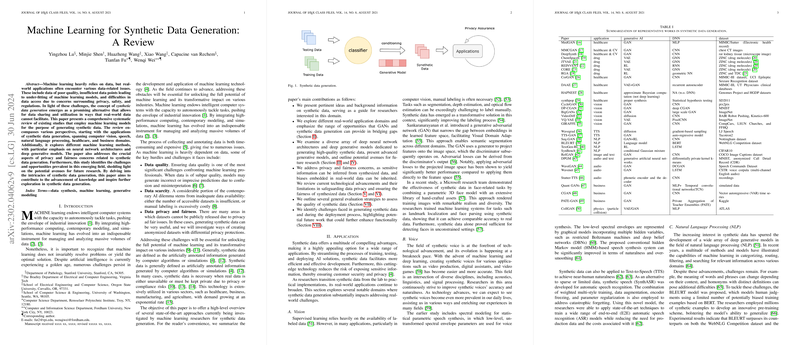Overview of "Machine Learning for Synthetic Data Generation: A Review"
The reviewed paper offers a comprehensive exploration of machine learning techniques employed in synthetic data generation, covering the fundamental motivations, challenges, and methodologies applied across diverse domains. The authors provide substantial insights into the utility of synthetic data, particularly in addressing limitations related to data quality, availability, and privacy concerns. This review synthesizes current research, highlights the success of deep learning models, particularly neural networks and generative models, and discusses issues of privacy and fairness in synthetic data generation.
The paper is organized into key thematic sections, each addressing distinct facets of synthetic data generation. These domains encompass computer vision, speech, NLP, healthcare, and business applications. Collectively, the paper underscores the transformative potential of synthetic data while recognizing the pressing challenges.
Key Areas of Focus
Applications
The review systematically discusses synthetic data applications, bifurcating into vision, voice, NLP, healthcare, business, and education domains. In vision, synthetic data mitigates labeling challenges, with techniques like GANs improving domain adaptability. In voice, synthetic data enhances speech synthesis, offering scalability in AI-driven communications. NLP applications leverage models like BLEURT and RelGAN for tasks demanding high-quality text generation, while the healthcare domain utilizes synthetic EHR data to ensure privacy without compromising analytical capabilities. Furthermore, applications in business focus on preserving privacy while adhering to regulations, emphasizing synthetic data's role in circumventing data-sharing limitations. Education and trajectory generation capitalize on synthetic data’s provisions for privacy, enhancing data-driven insights without compromising sensitive information.
Deep Neural Networks and Generative Models
The authors detail how varying neural network architectures—including MLPs, CNNs, RNNs, GNNs, and Transformers—are pivotal in synthetic data generation. Each architecture offers unique strengths, from the powerful modeling of spatial hierarchies in CNNs to the sequential learning of RNNs, advancing the generation and utility of synthetic data. The paper also elaborates on generative AI models such as VAE, GAN, and the diffusion model, emphasizing their innovative approaches for creating synthetic representations. These models, specifically GANs and diffusion models, have successfully generated high-quality data across multiple domains, reflecting significant advances in generative AI capabilities.
Privacy and Fairness
Privacy risks intrinsic to data synthesis, like membership inference attacks and data reconstruction, are thoroughly examined. The authors discuss differential privacy as an essential mechanism to safeguard against these threats. While existing methods leverage various privacy-preserving strategies, such as PLA and GANs with differential privacy, the need for continuous refinement and the emergence of new approaches is evident. Regarding fairness, the paper explores how synthetic data generation can mitigate biases present in training datasets. It raises critical insights on preprocessing, in-processing, and post-processing fairness strategies, advocating for amplified efforts in integrating fairness considerations across generative models, particularly within the sphere of AI-generated content.
Challenges and Futures
The inherent challenges in synthetic data generation, including evaluation metrics and handling outliers, are confronted in the review, setting a research agenda for future endeavors. The authors emphasize the crucial need for benchmarks to assess the quality of synthetic data and suggest integrated solutions to counteract biases. Future opportunities may focus on leveraging synthetic data to bridge limitations in data-available benchmarks, drive innovation, and ensure equitable AI deployment.
Conclusion
Synthesizing various methodologies and real-world applications, this review highlights synthetic data generation's potential to revolutionize data-driven insights while adhering to ethical constraints. By systematically addressing challenges and practical considerations, the authors provide a foundation for future research, encouraging advancements that enhance the efficacy, fairness, and utility of synthetic data. This review stands as a pivotal resource in the furtherance of synthetic data application and research, emphasizing the role of machine learning in transforming data paradigms.
